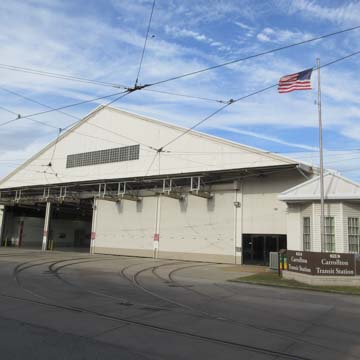In 1892, the St. Charles Avenue streetcar tracks were extended along the neutral ground of S. Carrollton Avenue to a new carbarn, where the Carrollton route of the New Orleans and Carrollton Railroad would terminate with a loop through the structure. The Berlin Iron Bridge Company of Berlin, Connecticut, constructed the nine-track steel-framed carbarn (265 feet by 128 feet), which has corrugated metal sides and a slate roof supported on steel trusses. Adjacent buildings for storage, oil, paint shops, and electric machinery were constructed of brick; a few years later, a repair shed with seven tracks was built next to the carbarn. In 1893, the railroad company converted to overhead electricity to power the streetcars, having the year before built an electric powerhouse of brick designed by Thomas Sully at Napoleon and Tchoupitoulas streets, to contain its boilers and three Corliss compound steam engines. The new electric cars, made by the St. Louis Car Company, were described in 1893 by the Daily Picayune as “elegantly made, and . . . furnished inside with carved cherry wood with spring seats, and back of woven bamboo. . . . The ceilings are of papier-maché, decorated with conventional designs of brown and gold.” The electrified line opened on February 1, 1893, to a performance of The Trolley Polka, a musical composition written for the occasion by Paul Tulane Wane. Soon dismissed were initial public fears that the electrical poles installed along the rail route would shock bystanders and that these much speedier streetcars would hit pedestrians. In 1923, the current streetcars, designed and built by the Perley A. Thomas Car Company of High Point, North Carolina, were introduced.
At 5600 Magazine Street, the Arabella streetcar barn of 1893, which began as the Mechanical Exhibits Building at the 1884 World’s Fair in Audubon Park, was converted into a barn for buses when they replaced the Magazine Street streetcars. In 2001 it was acquired by a supermarket and renovated for its new use. The rear half of the structure maintains its original appearance and vehicular use. Another former streetcar barn stands at 100 Poland Avenue in the Bywater neighborhood.


